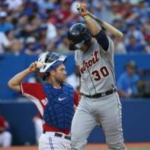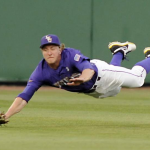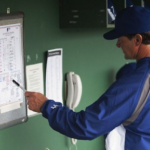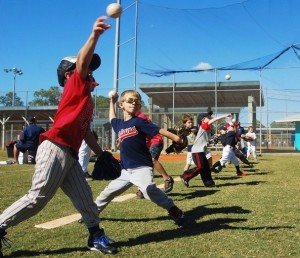How to Improve the Landscape of Youth Baseball
I sat down this morning and started writing a blog post about how I would organize a youth baseball league. To aid in my writing, I looked back at some of the comments from my readers on my blog, on twitter, on Facebook, and on LinkedIn and realized that my readers have an absolutely outstanding view on youth sports and youth baseball in general. So I decided to let you write this blog post by answering the following question...
"If you were starting a youth baseball league from scratch, how would you organize it, what would be different about your league, and what would your priorities be??"
I'll get us started with a big one in my mind... I would ensure at least one practice for every game. I look forward to hearing your responses and insight! In a few weeks, I will put together a post summarizing your comments!
Sign Up For Our Free Coaching Library
More from my site
 Mini – Playing the game the right way
Mini – Playing the game the right way CCA Podcast 119: Components of a great outfielder
CCA Podcast 119: Components of a great outfielder CCA Podcast 080: The ONE drill that will have you throwing 90 and dropping bombs
CCA Podcast 080: The ONE drill that will have you throwing 90 and dropping bombs The Most Important 20 Minutes of Practice
The Most Important 20 Minutes of Practice CCA Podcast 044 – Constructing your batting order to maximize your team’s output
CCA Podcast 044 – Constructing your batting order to maximize your team’s output CCA Podcast 250 – Holding runners around the bases
CCA Podcast 250 – Holding runners around the bases
 Posted by Kyle Nelson
Posted by Kyle Nelson- Posted in Uncategorized
 Oct, 27, 2013
Oct, 27, 2013 22 Comments.
22 Comments.
Elite members login here
Check out what’s New/Hot!
Recognizing, Diagnosing, and Fixing Common Hitting Flaws eCourse The 3 metrics we tested on Blast motion sensors this year Sneak Peek Inside an Elite Q and A The batting practice continuum Elite Member’s area table of contents 50+ “Chaos” hitting drills
5 sample Chaos hitting drills FREE
Mental Skills and Culture Building The hitting pyramid Welcome Elite Member, Trey! Ideas for a pitcher first practice 12 week bat speed improvement plan Make plans this offseason to have your team playing their best baseball at the end of the year” Top 5 hitting drills to translate practice skill to game performanceHow we used Blast Motion sensors with a team in 2019
What to do if your hitters are overmatched Welcome Elite Member, Tommy! Setting your baserunners up for success Welcome Elite Member, Mike! A consulting call with Elite Member Matt FREE Web Clinic: Developing Athletic, Consistent, Extraordinary Infielders
 Coach Kyle Nelson
Coach Kyle Nelson
At least 2 practices a week until the season starts, maybe 3. I think pitchers and catchers should start practice at least 2 weeks, maybe 4 before everyone else. There is a lot to learn and more responsibilities in those positions.
The more practice the better! Not to mention pitchers getting their arms in shape to pitch prior to jumping right into competitive situations. Great points!
I would avoid affiliation with any of the large national organizations that sanction post season all-star tournaments. I have several reasons for that.
One is that in order to compete in the post season all-star events, the regular season has to be wrapped up by about the first of July. That forces leagues to do a couple of negative things. One is that. to play a reasonable number of games, you have to start the season early – usually long before school is out. Practices therefore start even earlier in the year. You end up with kids and parents struggling to balance schoolwork and baseball for six weeks or more. And how about making sure those kids have enough sleep before school? Our local 9-12 year old league scheduled two games per night – one at 5:30 PM and one at 7:30 PM. If you drew the 7:30 game, you often weren’t leaving the park until 9:30 or even a little later. My kids often didn’t get to bed until after 10:30 PM on those nights – way later than I would allow them to stay up on a school night for anything else.
If you’re lucky enough to play in the north where I live, the weather in early May can be winterlike at times. There’s nothing like playing 9-12 year old baseball games at night in 40 degree temperatures with the wind howling.
The other negative thing that happens with the all-star thing is that you end up focusing an inordinate amount of coaching, practice and playing time on the 10 or 12 kids who happen to be the best players at their current age. Usually, it’s the kids who have grown or matured the fastest. If you ever look at a random group of 12 year olds, you have kids that are shaving. kids who are smaller than 4th graders and everything in between. If your league has 8 teams of 12 kids, you have roughly 100 in your program. If you’re sending an all-star team somewhere, you send 90% of the kids home in early July and devote a bunch of effort to try to help 10% of them become a champion of some sort. Most likely those 10 or 12 will inclued the “shavers” I mentioned earlier – the kids who mature fastest will often be the best players in their age group, it just stands to reason.
So, what happens to the 90% of the participants in your league – the kids you sent home in early July because they weren’t all-stars (and aren’t shaving yet)? They find something else to do – something other than baseball. Some will come back to play baseball again, but many get the message that they’re not good at baseball and will leave the game behind in favor of other pursuits. By focusing on a minority of your program participants, you stop the development of the rest.
I say push the calendar back. Start practices around the 15th of May with games around June 1 and play until late July. Wrap things up with a league playoff involving all the teams in your program. You’ll increase the level of participation, develop more players and make the whole thing more enjoyable for everyone.
@Fred-
I agree w/ the All-Star idea. I would be we lose a lot of young players to other sports who are not good enough to be an All-Star at age 9. It seems like we force kids into decisions at a young age, and the reality is, neither them nor their parents are equipped to decide if a 9 year old will be good, or have a passion for a game in 9 years.
@Jim-
It really does seem as though there is a “Travel or Bust” mentality in youth baseball (and other sports for that matter). It’s amazing how many “travel” baseball players try out for a high school team. I coach at a mid-sized school and we have had as many as 36 “travel” players try out for our freshmen team. At larger schools, that number is doubled, or tripled.
The thing that shocks me (and part of my reasoning behind starting Cornerstone) is the lack of resources put into the coaches in these leagues. Even if they weren’t hired… they were just given resources to be successful, coaches could produce a much more enjoyable experience for their athletes.
As I expected… great feedback!
I did not even consider having my son play travel ball until his last year of little league. Its too much for young players, combined with school and other activities for kids. If you put too much on their plates they will eventually hate it and quit. Kids need to be kids and enjoy their youth. Once I knew my son wanted to continue beyond LL and his talent level was on par with travel ball and he wanted to play travel ball it was a easy choice. Make sure of the team and coaches that you put your son on. I did my homework first by watching practices and a few games before I trusted them with our son. Our son just graduated from La Costa Canyon HS in San Diego and earned a baseball scholarship to a D-1 College, San Jose State. In little League at beginning 2 to 3 practices a week before the season starts, then once a week is plenty. Don’t overload kids, teach them the basics and try to stay up beat and positive. little league is pure, so much fun so remember its not travel ball. Enjoy it the time with you son or daughter because before you know it, its ALL OVER! One of the biggest lessons I learned is that not every kid loves baseball and is as competitive like myself or my son so you need to adjust to that. Once All Stars start you can Coach a bit more aggressive or wait until travel ball. good luck and enjoy.
Excellent points, for every one hour of game time – there should be four hours of fun practice for the young players. Early spring games are absurd and turn everyone off to the game at a young age. Your concept of May is great and let’s focus on the 90%ers.
Put the right coaches in place and provide coaching lessons. Our local high school coaches come to a manager/assistant manager meeting at the beginning of the year. They break down into classes for different ages and show youth coaches different techniques. As a coach, you can only teach what you know and we always learned something new from the other coaches.
Coach collaboration is a great way to share ideas. Some coaches know more than others, but if they can collaborate all of that information together it could be a great resource for youth coaches!
You’ve opened a Pandora’s Box with this one! As someone who ran one of Chicago’s largest youth leagues and now owns a training academy, I’ve got a few dozen thoughts on this subject.
But I’ll limit it to this. Youth baseball is at a crossroads. Travel baseball is fast eroding the numbers in the youth leagues. Not because of the elite teams, but because of the teams now poaching the average players (many of which are organized and run by academies to make money). My fear is that, if things continue in that direction, we will eventually see many leagues closed up.
My suggestion is this. Give the players in the leagues the opportunity to play for their house league’s travel/all-star teams with the requirement that every travel player has to play for their house team in 90% number of games.
Then hire professional coaches to run those teams. The players will get the same or better coaching than they will from many of the full-time travel teams, which is a big reason parents say they move their kids to full-time travel. Also, it removes the “dad coach” aspect, which is also a big reason many parents pull their kids from the house league.
Whatever we do these days towards strengthening youth baseball has to strengthen the house leagues or I fear that the game will not survive.
Well the tension between travel and house league won’t go away. I love the idea of hiring professional coaches and lots of practices. I think a key that no one ever does is have a structure where independent reviewers go to some practices, talk to the coaches and give them ideas on what they have seen and what they improve. I have coached little league for 15 years at all levels and I have run our training for coaches for a few years. I see coaches nod knowingly in the training sessions and then go out and do what they have always been doing — have kids standing around waiting for slow running drills to materialize.
Practice has to be fun and engaging and timeless and it has to focus on the mechanics instead of the outcomes. Saying that is easy — doing it is incredibly hard. Getting new, overworked, tired dads to do it who often have a few young kids is really asking too much.
I think fundraising is key as that would enable leagues to be able to afford to hire coaches. I have been in England for two years and I’m watching the professional coaches play each other in the the 9-12 age group and I’m just taking notes. They are lower key -they don’t have the whole parenting aspect — they don’t have favorites because they are friends with various parents — they just do the job and they almost never focus on outcomes. I wish they had a little more enthusiasm for what they are doing — but seems like that can be fixed with the hiring process.
I’ll look forward to your summary on this. Overall though, leagues really lack the infrastructure to go hire say 50-60 coaches and the funds to pay them. So its all a good idea, but it hurts my brain to figure out how to implement it.
DG
David-
Thanks for your comments and great insight as always! I hope to create a “Utopian” league, but then also have some recommendations for implementation.
Kyle
2 practices to every game.
3rd, 4th, 5th, 6th graders would play in house games(no travel)
7th, 8th, 9th graders would play in house and travel for weekends(tournaments)
I want the kids playing as much as their bodies can handle.
I would push for kids to play other sports during those other sports seasons.
I would want my organization to offer lessons, camps/clinics in the baseball off-season.
I would consider the Baseball season to be March 15th – August 15th.
I think a solid throwing program & Hitting program should be established league wide to get the season started.
I think coaches should be recruited from the colleges in the community with Teaching/Coaching programs backgrounds. There should be a hiring seminar and hours earned program for these coaches, with a small stipend but mainly it would get them their “field credits” for course work.
I strongly believe that you should set up within your organization,rules that enforce minimum game time participation requirements (Equal Play Time) for all participants.I would suggest a minimum of at least 2 innings per game if not more.Kids are kids for only so long,even as adults we still want to have fun and play sports. Why is it as adults,we share game time with one another in various sports,yet we continue to sit these kids because they might not be blessed with certain athletic skills.
I think you could take it a step further than kids playing two innings per game. For in house leagues, coaches should be able to split up playing time a big more evenly. Assuming there are 12 kids on a team, that’s 3 sitting out each inning. Really, no player should play less than four innings in a six inning game. I have coached in fall leagues (high school age and a bit more competitive) where we used a continuous batting order the whole season. Pick up the following game with the player who was on deck when the last out was made.
Doug- I am totally on board with your initiative. Keep up the good work!
Hey all,
All great points…
To take it further, my biggest issue is the lack of quality coaching…and its not for the lack of effort from the parent taking on the responsibility and time commitment.
dschildgen makes a great point A great point about having young, knowledgeable players such as college players or high school players volunteer with the local youth baseball league. That said, it will be tough for a local college player help while in season March – June. But with the high schooler, he may have more time because they are not traveling and should have more time on the weekends. As a HS coach, many of my players volunteer with some of the youth teams and travel teams as well. And like dschildgen was saying, they get volunteer hours (in my case Key Club) for helping our local youth. These are the type of kids you want helping our youth baseball players.
Youth leagues should be in contact with their local high school coaches and teams and tap into them as a resource.
came across this article from Marc Lindin at Baseballpositive.com…some great ideas on how to play at the youth level. “Herding cats, can the tee-ball experience be improved?”
http://www.baseballpositive.com/#!blank/c1ipj
I knew I heard that phrase “Herding cats” somewhere recently to talk about tee-ball. It’s a very accurate description and that is the first place I believe we have to improve. I have my own ideas about that and will post them in my synopsis.
Kyle
I feel like I need to respond or add to some of these comments. With little league. I feel there has to be an advanced league. I’ve had kids get bored or have a negative attitude when the ability of the other players were not at the same level as them. I don’t feel like moving those advanced players to older leagues is the answer.
March to August is just too long. Do they really need to play the same amount of time as high school players do? That’s where playing other sports is a benefit. They keep you in shape and work different muscles. More muscles being trained results in overall strength and stamina increasing.
Concerning coaches. Little league is all about the dad, grandpa, and anyone wanting to commit to be coaches. They have to be willing to learn just like the players. There should be expectations set for those coaches to comply to.
Camps are a great idea. They should be run by college or pro experience coaches, players if possible. Mechanics should be the focus. Results will happen eventually. I have a camp in April and have 2 former college players and a seasoned local camp instructor to volunteer some of their time to our program. Along with the little league coaches teaching and learning at the same time. We are scheduling it that way.
Playing time issues. Why not run until the 3 outs or the entire bench and that’s it.Then switch. I would really only use this for 8-9 age group. It will make it more possible to get in more innings while using a declared time limit.
I also believe that kids should not be a pitcher and a catcher. Too much physical stress that will catch up to them later in life. Not all, but most.
Coaches should be able to coach less as the season nears it’s end. Everything should become second nature and some of your players should be taking on more of a leadership role for the team. It shows maturity and the ability to handle responsibilty. Not to mention. It shows that they are learning what you are teaching.
Dale-
I totally agree about the pitching/catching thing. We have a lot of kids come up doing both and I tell them they are going to have to make a choice by the time they get to high school. It is just too much stress on the arm.
Your post made me think of a speed up rule for younger kids to make games go quicker. Clear the bases after 3 outs and let that team keep hitting, then switch after 6 outs? Might implement that for 5-8 year olds to minimize transition time.
Kyle
Myself and my partner Dan (both coaching parents with combined coaching experience of 30 years+ within youth sports)are trying to make Equal Play Time the new benchmark for all youth sporting events.We have been using our board for over 5 years now and both kids and coaches love this coaching tool.This is a perfect tool to help grow all youth baseball programs. Participation is the key. It should be all about the kids.Please visit us at http://www.equalplaytime.com Thx and all the best Doug
This is a great topic, and one I’ve thought about for awhile. My approach is probably more radical than most. I would target my idea at rec-league type players as “travel” players and parents will do what they do.
I was thinking of how could we combine the fun of playing pickup baseball, like when we were kids, with solid development? As a kid I played in a league like everyone else, played all stars, etc. But I also went to the park nearly every summer day off school and played with whomever was hanging around. I was probably not the only one to enjoy those pickup games 100% more than the league games.
So how about a “league” where kids sign up, attend training twice per week and play 1 game on the weekend. Training is a combination of field work and classroom work. But it is run more like a clinic with quality instructors and every kid learns the same things. They all learn to pitch, catch, hit, etc. by the training staff. Parents also attend all the training so they have tools use with their children at home.
Norway High School in Iowa was very successful using older kids to teach the younger kis, so I think that’s a good approach. And although most current Hich School and College players’ schedules would not allow, there are many local players whose careers are over that I believe would love to give back. Using these young ex players with a mix of paid instructors from local training centers and colleges should provide the expertise needed. One coordinator or small board could set the cirriculum and schedule.
How do games work? I’d run them like pick up games. No one is on an actual team, rather kids get assigned a game time, they show up and pick teams. An instructor is there to help things run smoothly. No umpires (use the money for more instructors), use dads etc.
It’s possible that it could be complete chaos, but the instructor and dads present can help move the game along. Imagine kids setting lineups, deciding positions etc. Learning decision making, strategy, leadership, getting to play with various teammates and learning many positions. We all did this with no adults around.
There would be no standings, just lots of fun baseball, learning and playing with their friends.
… [Trackback]
[…] Informations on that Topic: cornerstonecoachingacademy.com/how-to-improve-the-landscape-of-youth-baseball/ […]